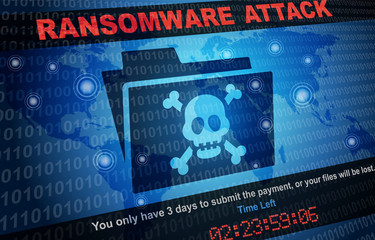“Uncover the world of ransomware attacks, from how they work to real-world examples like WannaCry and Colonial Pipeline. Learn actionable tips to protect your data and stay ahead of hackers in this comprehensive guide to ransomware.”

Introduction
Imagine waking up one day to find all your files locked, your systems unusable, and a ransom note demanding payment in cryptocurrency. This isn’t a scene from a sci-fi thriller—it’s the harsh reality of ransomware attacks, one of the most prevalent and devastating cyber threats today.
In this blog, we’ll unravel the mystery behind ransomware, how these attacks are executed, real-world examples, and most importantly, how you can protect yourself and your organization from falling victim to these digital extortionists.
What is Ransomware?
Ransomware is a type of malicious software (malware) that encrypts a victim’s data, rendering it inaccessible. Attackers then demand a ransom, usually in cryptocurrency, in exchange for a decryption key to restore access.
Key Characteristics of Ransomware:
- Data Encryption: Files are locked using strong encryption algorithms.
- Ransom Demand: A note is displayed, instructing victims on how to pay the ransom.
- Double Extortion: In some cases, attackers threaten to release sensitive data if the ransom isn’t paid.
How Ransomware Attacks Are Executed
Ransomware attacks typically follow a structured approach:
1. Infection (Initial Access):
- Phishing Emails: Victims unknowingly click on malicious links or download infected attachments.
- Exploiting Vulnerabilities: Attackers exploit software flaws or use brute force attacks to gain access to systems.
- Malicious Websites: Victims visit compromised websites that silently download ransomware onto their systems.
2. Propagation:
- Once inside the network, ransomware spreads laterally to infect multiple devices.
- Tools like Mimikatz or PsExec are often used to escalate privileges and move deeper into the network.
3. Encryption:
- The ransomware encrypts files using advanced algorithms like AES-256, making them unusable without the decryption key.
4. Ransom Demand:
- Victims are presented with a ransom note, often displayed on the screen, demanding payment in exchange for the decryption key.
5. Extortion (Optional):
- In double-extortion schemes, attackers threaten to publish sensitive data online if the ransom isn’t paid.
Real-World Examples of Ransomware Attacks
1. WannaCry (2017):
- What Happened?
The WannaCry ransomware exploited a vulnerability in Windows SMB protocol, infecting over 200,000 devices worldwide. - Impact:
Estimated damages exceeded $4 billion, with major disruptions in healthcare, banking, and transportation sectors. - Lesson Learned:
Always update and patch systems to fix known vulnerabilities.
2. Colonial Pipeline Attack (2021):
- What Happened?
The DarkSide ransomware group targeted Colonial Pipeline, leading to a fuel supply crisis in the U.S. - Impact:
The company paid a $4.4 million ransom to regain access to their systems. - Lesson Learned:
Critical infrastructure must prioritize robust cybersecurity measures.
3. REvil Ransomware (2021):
- What Happened?
REvil targeted Kaseya’s IT management software, affecting over 1,000 businesses globally. - Impact:
Attackers demanded $70 million in ransom. - Lesson Learned:
Third-party vendors can become a significant attack vector.

How to Protect Against Ransomware Attacks
1. Regular Backups:
- Maintain offline backups of critical data to ensure quick recovery without paying a ransom.
2. Update and Patch Systems:
- Regularly apply security patches to fix known vulnerabilities.
3. Implement Email Security:
- Use email filters to block phishing attempts and malicious attachments.
4. Multi-Factor Authentication (MFA):
- Add an extra layer of security to prevent unauthorized access.
5. Network Segmentation:
- Isolate critical systems to prevent ransomware from spreading laterally.
6. Endpoint Protection:
- Deploy advanced antivirus and endpoint detection tools to identify and block ransomware.
7. Educate Employees:
- Conduct regular cybersecurity training to teach employees how to spot phishing emails and other threats.
Emerging Trends in Ransomware
- Ransomware-as-a-Service (RaaS):
- Cybercriminals sell ransomware kits to other attackers, making it easier to launch attacks.
- Triple Extortion:
- In addition to encrypting data and threatening leaks, attackers may also target a company’s clients or partners.
- AI-Driven Attacks:
- Artificial intelligence is being used to create more targeted and sophisticated ransomware campaigns.

Resources and References
- National Cybersecurity Alliance – Ransomware Guide
- Colonial Pipeline Ransomware Attack Overview – BBC
- Understanding WannaCry Ransomware – Microsoft
Conclusion
Ransomware attacks are a stark reminder of the ever-evolving nature of cyber threats. Whether you’re an individual or an organization, understanding how ransomware works and implementing robust security measures is the key to staying protected.
💬 Your Turn:
Have you or your organization experienced a ransomware attack? What steps did you take to recover? Share your insights in the comments below!
Table of Contents
More
- Zero-Click Nightmare: Samsung Devices at Risk from CVE-2024-49415 Exploit
- Deepfake AI in 2025: What You Need to Know to Stay Safe
- IoT Security Demystified : Why Your Smart Devices Could Be Hackers’ Next Target 25
- CVE Explored: Understanding Common Vulnerabilities and Exposures for Better Cybersecurity 24
- Cyberattack on Japanese Airlines: How Hackers Grounded Japan’s Skies! 2024
- Shocking Chrome Extension Scandal: 600,000 Users’ Data Exposed in Massive Breach!
- AI-Driven Cyber Threats: Understanding and Mitigating the Risks of Artificial Intelligence in Cybersecurity
- Quantum-Resistant Cryptography: Protecting Data in the Age of Quantum Computing 15
- Multi-Factor Authentication (MFA): Strengthening Security with Layers of Protection 14
- Zed Attack Proxy (ZAP): A Hacker’s Best Friend 13
- What is an IDOR Attack? A Beginner’s Guide to Insecure Direct Object References 12
- VAPT Demystified: A Complete Guide to Vulnerability Assessment & Penetration Testing 10
- Hackers Playbook: 15 Common Cyber attack Techniques
- 9 Career Job in Cybersecurity : A Comprehensive Guide




